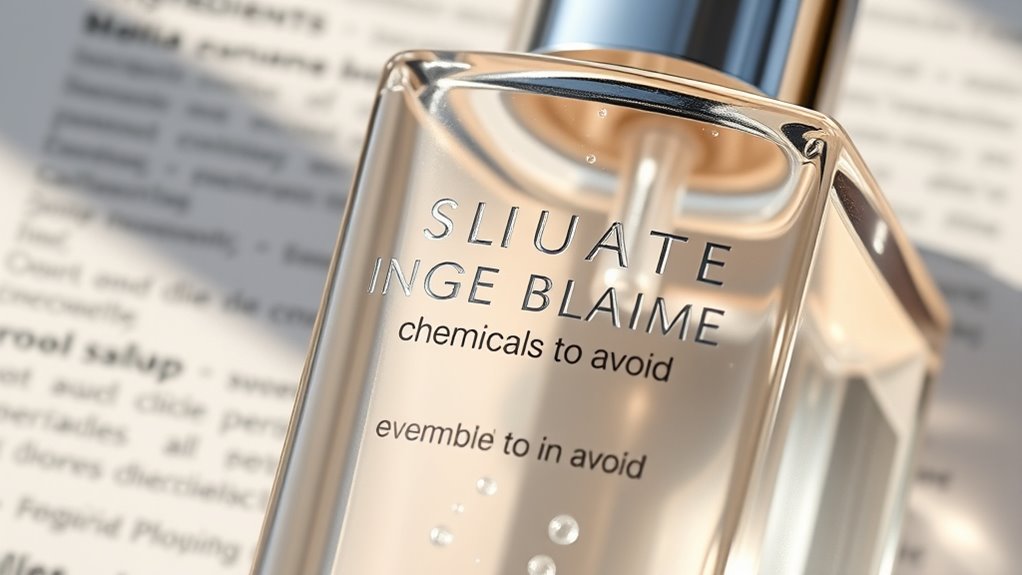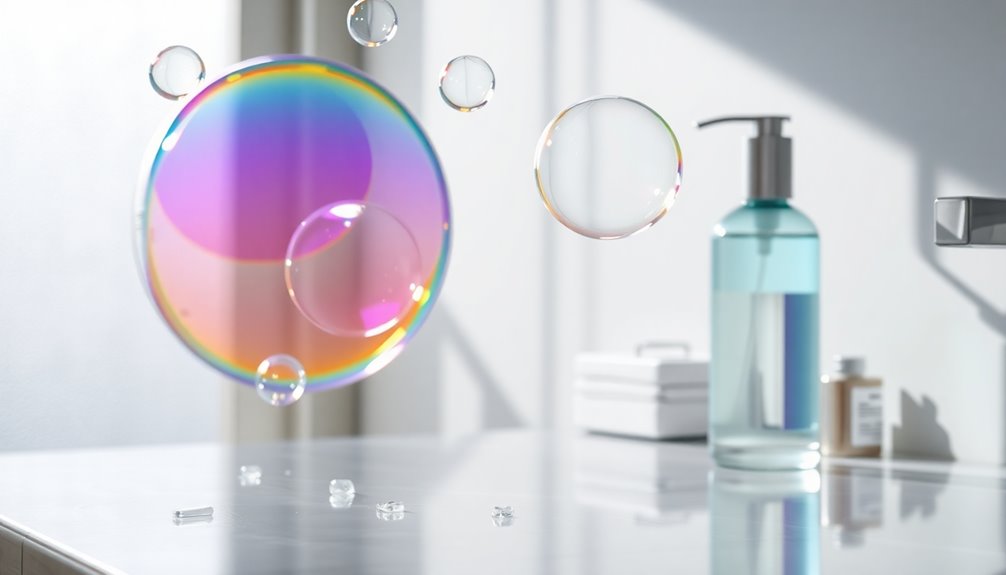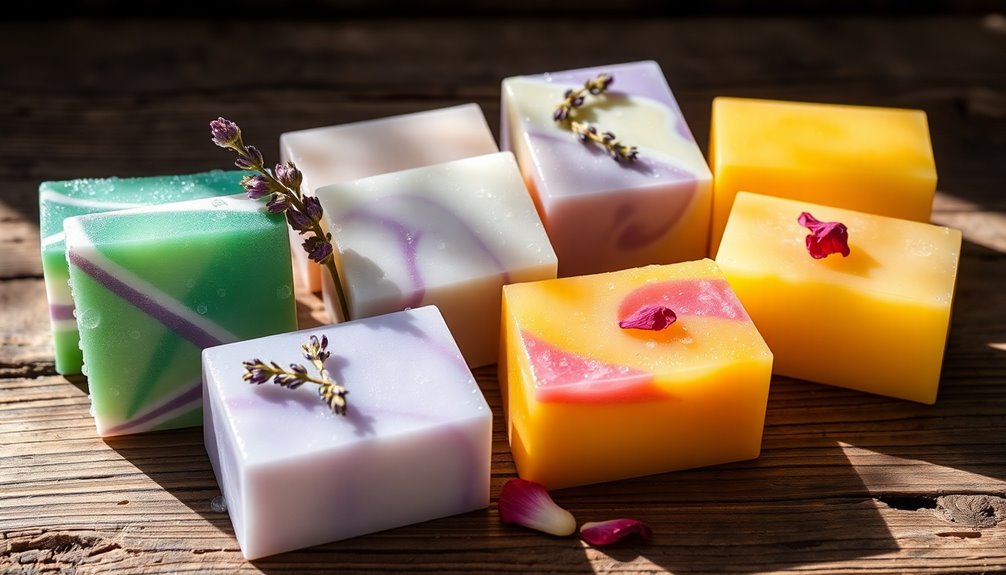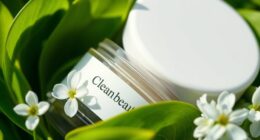When checking beauty product labels, it’s wise to avoid chemicals like parabens, formaldehyde releasers, phthalates, and synthetic fragrances, as these can disrupt hormones, cause skin reactions, or pose health risks. Look for natural ingredients and recognize unfamiliar or synthetic terms to make safer choices. Understanding what’s in your products helps protect your health and skin. If you want to learn about all 10 chemicals and their risks, keep exploring to become a savvy label decoder.
Key Takeaways
- Recognize synthetic preservatives like parabens and formaldehyde releasers that may disrupt hormones and cause skin sensitivities.
- Read ingredient lists carefully to identify chemicals linked to health concerns, such as phthalates and certain alcohols.
- Understand that natural ingredients are simpler, less processed, and generally safer than synthetic chemicals.
- Be aware that some labeled “natural” products may still contain harmful synthetic preservatives; always verify ingredients.
- Prioritize skincare products with natural ingredients to reduce exposure to potentially harmful chemicals and support skin health.

Have you ever looked at a beauty product label and felt overwhelmed by the list of ingredients? It’s common to feel confused, especially when trying to decipher what’s good for your skin versus what could be harmful. When you’re inspecting labels, one of the first things to notice is the focus on natural ingredients versus synthetic preservatives. Natural ingredients come from plants, minerals, and other organic sources, which many people prefer because they’re generally gentler and less likely to cause irritation or long-term health issues. Conversely, synthetic preservatives are added to prolong shelf life and prevent bacterial growth, but they often raise red flags because they can cause allergic reactions or irritate sensitive skin.
Understanding the distinction is key. Natural ingredients, like aloe vera, chamomile, or coconut oil, are often listed in simple, recognizable terms. They’re derived from nature and tend to be less processed, meaning they’re less likely to contain harmful chemicals. When you opt for products with natural ingredients, you’re choosing formulations that work in harmony with your skin and body, reducing your exposure to potentially toxic substances. On the other hand, synthetic preservatives such as parabens, formaldehyde releasers, and certain alcohols are added to keep products stable over time. While they serve an important function, research suggests some synthetic preservatives might disrupt hormones or cause skin sensitivities over prolonged use.
Choose natural ingredients like aloe vera and coconut oil to support your skin and reduce exposure to harmful chemicals.
Deciphering labels requires a bit of knowledge. Look for ingredients like parabens, phthalates, and synthetic fragrances, which are often associated with adverse health effects. If you see these, consider whether the product aligns with your health priorities. Many brands now highlight their use of natural ingredients and avoid synthetic preservatives, making it easier for you to make informed choices. But don’t assume that all products with natural ingredients are completely free from synthetic preservatives; some may contain them in small amounts. Checking ingredient lists thoroughly helps clarify what’s truly inside. Additionally, awareness of the various Glycolic Acid benefits can help you better understand how certain ingredients work to improve your skin’s health.
Ultimately, the goal is to make conscious decisions based on your skin’s needs and your health concerns. Reading labels carefully and understanding the role of natural ingredients versus synthetic preservatives allows you to avoid unnecessary exposure to chemicals that might do more harm than good. When you prioritize natural ingredients and minimize synthetic preservatives, you’re taking active steps toward safer, more wholesome skincare. This awareness empowers you to choose products that support your well-being without sacrificing effectiveness.
Frequently Asked Questions
Do Natural Ingredients Always Mean a Product Is Safe?
You might think that natural ingredients always mean a product is safe, but chemical misconceptions and natural ingredient myths can be misleading. Just because something’s labeled natural doesn’t guarantee it’s free from allergens or irritants. Always read the ingredient list carefully, as some natural ingredients can cause reactions. It’s essential to stay informed and not assume safety based solely on a product’s natural label, because safety depends on the specific ingredient and your skin’s needs.
How Can I Identify Allergic Ingredients on Labels?
To identify allergic ingredients on labels, you should look for clear allergen labeling and prioritize products with ingredient transparency. Read the list carefully, noting common allergens like fragrances, preservatives, or certain dyes. If you’re unsure, do a patch test before full use. Being vigilant about ingredient transparency helps you avoid potential allergens and ensures safer skincare choices tailored to your sensitivities.
Are Organic Products Necessarily Free of Harmful Chemicals?
While organic products often sound safer, they aren’t necessarily free of synthetic additives or artificial fragrances. You might think they’re completely natural, but some organic brands still use certain chemicals to preserve freshness or enhance scent. Always read labels carefully, as “organic” doesn’t automatically mean free from all potentially harmful ingredients. Your best bet is to educate yourself on what ingredients to look for, regardless of the product’s label.
What Labels Indicate Cruelty-Free or Vegan Products?
You look for labels that indicate cruelty-free certifications or vegan labeling standards to identify ethical products. Cruelty-free certifications, like Leaping Bunny or PETA, confirm no animal testing, while vegan labels guarantee no animal-derived ingredients are used. These labels help you make conscious choices aligned with your values. Always check for reputable seals, and remember, clear certifications make it easier to trust the product’s ethical stance.
How Often Do Ingredient Lists Change on Beauty Products?
Imagine your favorite beauty product as a book; its ingredient list is its story. Ingredient list updates and packaging label changes happen periodically, often every few months or with reformulations. You might notice small shifts or new warnings. Staying attentive guarantees you’re aware of these changes, much like a reader keeps up with new chapters. Regularly checking labels helps you avoid unwanted chemicals and make informed choices for your skin’s health.
Conclusion
Now that you know which chemicals to watch for, reading labels becomes your secret weapon. Imagine peeling back layers to reveal pure, honest ingredients shining through like sunlight on clear water. With each product, you’re crafting a safe, glowing future—your skin’s own symphony of health and beauty. Trust your eyes, trust your choices, and let your empowered gaze guide you toward products that nourish and protect, turning everyday routines into a mindful, radiant ritual.










